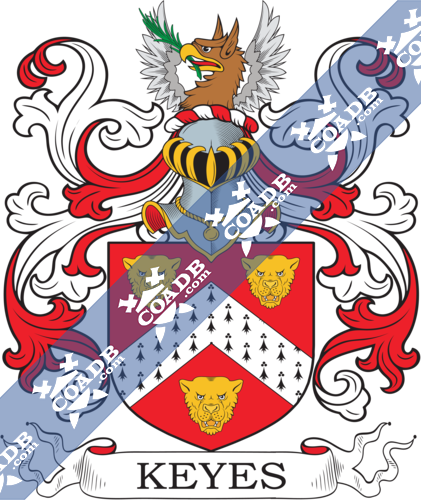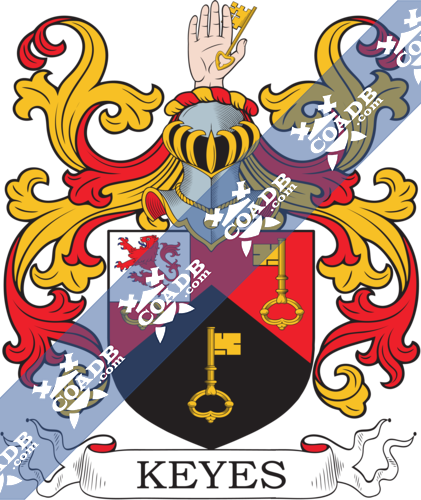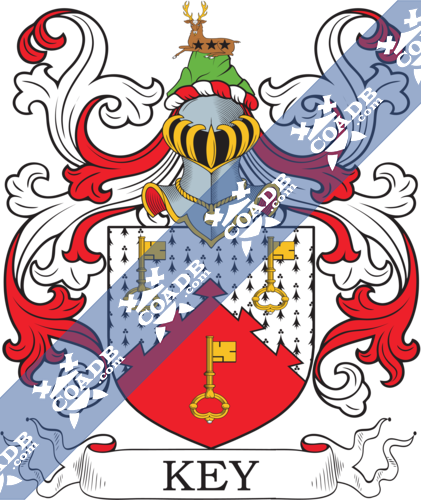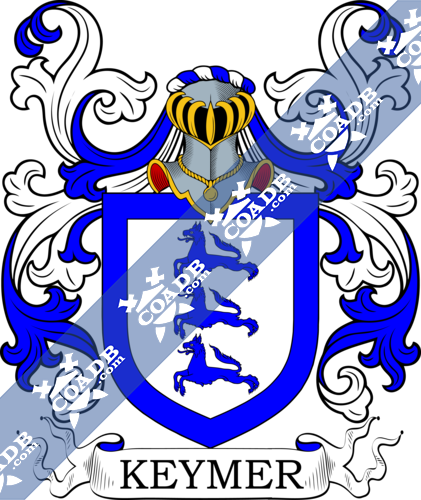Keyes Family Crest, Coat of Arms and Name History

Keyes Coat of Arms Gallery
Don’t know which Coat of Arms is yours?
We can do a genealogical research. Find out the exact history of your family!
Learn MoreKEYES
As with many surnames, their origins may come from many sources, the surname Keyes is no exception. This name may be derived from one of four sources. The first being Anglo-Saxon in origin. The name is derived from the medieval English word “caeg” which translates to “key”. “Caeg” was often used to refer to an individual who was a key maker or was charged with the commission of holder of keys. Therefore, in this context, the name was occupational. The second source of origin is again, Anglo-Saxon. The name is said to have derived from the medieval English word “kaye” which translates to “wharf”. In this context the name could be considered occupational or topographical as it could be used to describe the location where someone lived or could be in reference to the place where they worked. The third states the name or any one of the variation of its spelling is derived from the Roman given name Gaius or Caius, brought to the British Isles during the age of the Roman Empire. The last states the name or any one of the variation of its spelling is of Norman in origin, having come over when William the Conqueror invaded Britain in 1066. In this context the name would be topographical, derived from the town of Guise in France.
Variations in the spelling of the name do exists, besides Keyes, the name has also been recorded as Keyse; Key; Keye; and Keys among others. The array in variations in the spelling of surnames, as well as many “given” names that exists today, can be attributed to a lack of consistency regarding guidelines for spelling in use by the scribes who recorded such information dating back to ancient times. Many of these record keepers were in the habit of spelling phonetically, however, what may have sounded one way to one person may have sounded completely different to another. The issue of multiple spellings of names in records was compounded by the diversity of languages in use in European countries at this time.
The use of surnames did not come into vogue in Britain until after the Norman invasion and the conquest. Most residents in the small settlements and villages which existed during earlier periods across most of Britain, found little need for surnames as everyone within these communities knew each other and a given name would usually suffice. However, as communities grew and people began to migrate on a larger scale, along with the need of the government having a reliable way to track people for tax and census purposes, the Norman aristocracy’s penchant for using surnames seemed the appropriate evolution to this problem. In most instances to distinguish themselves, one from another, those not of the noble class would often be identified by their given name plus their occupation while others may have been identified by their given name and one of their parent’s names. There was a boundless supply from which surnames could be formed, in addition to the use of patriarchal/matriarchal names or reference to the individuals occupation, there were things such as defining physical traits, a familiar geographical location or a topographical landmark found near the individual’s home or birthplace, the name of the village in which the person lived, and so much more. Over the course or time, surnames came to represent not just individuals but whole families.
In the earlier days of record keeping in Britain, one of the first appearances of the name can be found in the tax rolls from Worcestershire dated 1275 showing a listing for Roger Keys. The tax rolls, were a series of census and tax records kept by the English Treasury by order of King Edward I, with the oldest dating back to the 12th century. These documents are considered the oldest concentric set of records documenting English governance in the United Kingdom spanning a period of over seven centuries, these records have proven invaluable to researches over the years.
With the discovery of the Americas, immigration to these new worlds was inevitable. Some of the first recorded immigrants to America bearing the surname or any variation of the spelling were Thomas and Daniell Keyes who arrived in 1638 and settled in Virginia. Walter Keyes landed and settled in Virginia in 1650, Solomon Keyes landed in Newbury, Massachusetts in 1654, and Richard Keyes landed and settled in Virginia in1658.
There were also many immigrants to the British Commonwealth country of New Zealand bearing the surname Keyes. Brothers, Alexander and William Keyes landed in 1875 and settled in Auckland, New Zealand.
Worldwide, the highest concentration of people with the surname Keyes are found in Ireland, the United States, Canada, Australia, and the United Kingdom. State by state, the largest percentile of those with the surname Keys is in Mississippi, Utah, and Vermont.
There are many persons of note who bear the surname Keyes. Roger Keyes, 1st Baron of Keyes was an Officer in the Royal Navy. His title id found in the Peerage of the United Kingdom, created for him in 1943.
Blazons & Genealogy Notes
1) (co. Kent). Gu. a chev. erm. betw. three leopards’ faces ar. (another, or). Crest—A griffin’s head betw. two wings, holding a palm branch ppr.
2) (Cavanacor, co. Donegal; granted to Thomas John Hudleston Keyes, Esq., Major Madras Army, and Charles Patton Keyes, Esq., C.B., Lieut.-Col. Madras Staff Corps, only surviving sons of Thomas Keyes Esq., Asst. Surg. Madras Army, by Mary Anne, his wife, dau. of William Patton, Esq., of Croghan, co. Donegal). Motto—Virtute adepta. Per chev. gu. and sa. three keys or, the wards of the two in chief facing each other, and of the one in base to the sinister, on a canton ar. a lion ramp. of the first. Crest—An open hand couped at the wrist ppr. holding betw. the forefinger and thumb a key or.
3) Quarterly, or and az. four crescents counterchanged. Crest—Minerva’s head ppr.
4) (granted to Rev. Roger Keys, and Thomas Keys, his brother, who had been engaged in the works of Eton Coll., temp. Henry VI.). Per chev. gu. and sa. three keys or, the wards of the two in chief facing each other.
5) (impalement Fun. Ent. Ulster’s Office, 1622, Henry Stanihurst, whose wife was Sybell, dau. of Captain Keys). Sa. a chev. betw. three keys erect or, wards to the dexter.
6) Gu. a cross crosslet or.








